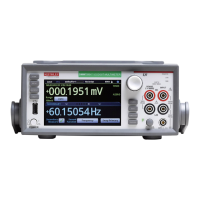7½ Digit Graphical Sampling Multimeter Reference Manual Section 3:
DMM7510-901-01 Rev. B / May 2015 3-13
Reading buffers
Reading buffers capture measurements, ranges, and instrument status. The Model DMM7510 has
two default reading buffers. You can also create user-defined reading buffers.
Reading buffers provide statistics, including average, minimum, maximum, and standard deviation. If
you use SCPI commands over the remote interface, peak-to-peak statistics are also available.
When you create a reading buffer, that buffer becomes the active buffer until you choose a different
buffer.
You can perform the following operations on reading buffers from the front panel or the remote
interface:
• Configure, store, and recall reading buffers. Only one reading buffer is active when you control
buffers from the front panel.
• View reading buffer content.
• Choose to store readings in the default reading buffers or the user-defined reading buffers.
• Save reading buffer content to a USB flash drive.
• Set reading buffers to fill once or fill continuously.
• Change the capacity of reading buffers.
• Delete user-defined reading buffers. You cannot delete defbuffer1 and defbuffer2.
• Clear reading buffers.
• Clear the default reading buffers and delete the user-defined reading buffers by turning the
instrument off or sending an instrument reset command.
Getting started with buffers
The following sections provide you with information to help you start using reading buffers. The
Remote buffer operation (on page 3-30
) section provides additional information about accessing the
reading buffers with remote commands.
Using default buffers
There are two default buffers, defbuffer1 and defbuffer2.
If you do not select a specific buffer, all readings are stored in defbuffer1. If you want to store
readings in defbuffer2, you need to select it. If you want to store readings in a user-defined buffer,
you need to create the buffer. The user-defined buffer is automatically set to be the active buffer. New
readings are stored in the active buffer, unless the buffer created has the writable style.
Effects of reset and power cycle on buffers
The instrument clears the default buffers when a reset command is sent or when the power is turned
off and then turned on again.
The instrument deletes all user-defined buffers when a reset command is sent or when the power is
turned off and then turned on again.
The active buffer is cleared when the function is changed using the front panel.

